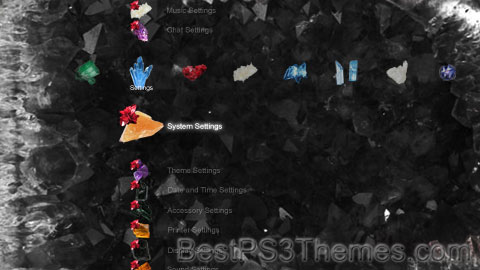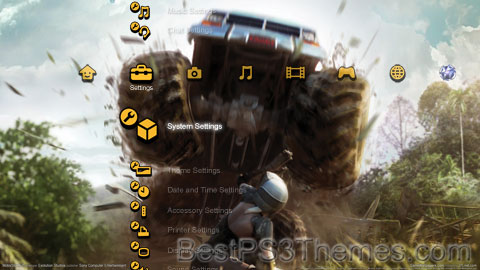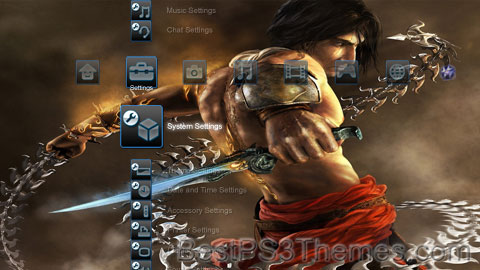Saints Row 2 theme by snoopy
Download: SaintsRow2.p3t
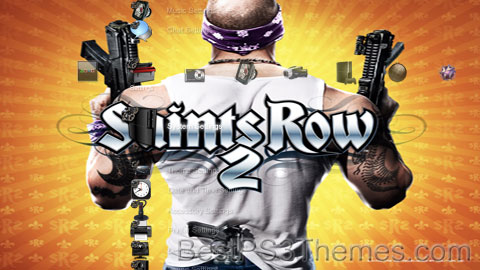
(3 backgrounds)
| Saints Row 2 | |
|---|---|
 | |
| Developer(s) | Volition[a] |
| Publisher(s) | THQ Deep Silver (Linux) |
| Director(s) | Clint Ourso |
| Producer(s) | Greg Donovan[4][5] |
| Designer(s) | Scott Philips[6] James Tsai[7][8] |
| Programmer(s) | Nicholas Lee Jeff Thompson |
| Artist(s) | Frank Marquart |
| Writer(s) | Steve Jaros Drew Holmes |
| Series | Saints Row |
| Platform(s) | Microsoft Windows[9] PlayStation 3[10] Xbox 360 Linux |
| Release | PlayStation 3, Xbox 360[1][2] Windows Linux[3]
|
| Genre(s) | Action-adventure |
| Mode(s) | Single-player, multiplayer |
Saints Row 2 is a 2008 action-adventure game developed by Volition and published by THQ. It is the sequel to 2006's Saints Row and the second installment in the Saints Row series. The game was released in October 2008 for the PlayStation 3 and Xbox 360, January 2009 for Microsoft Windows, and April 2016 for Linux. A mobile tie-in game was developed by G5 Entertainment and also released in October 2008. Saints Row 2 directly follows from the events of the first game, as the player's custom character awakens from a coma after five years[11] to find that their gang, the 3rd Street Saints, has been disbanded, and their former territories taken over by newly-formed criminal syndicates and a corrupt corporation. With the help of new and old allies, the player attempts to rebuild the Saints and take back Stilwater from their rivals.
Story missions are unlocked by trading in "Respect" points, currency earned by completing minigames and side-missions. Outside of the main story, players can freely roam Stilwater, which has been expanded with new locations and consists of two main islands. The game is played from a third-person perspective and its world is navigated on-foot or by vehicle. Players can fight enemies using a variety of firearms, and call in non-playable gang members to assist them. An online multiplayer mode allows two players to explore Stilwater together while completing missions and activities, or multiple players to engage in a variety of cooperative and competitive game modes.
Saints Row 2's developers opted for a more comedic tone to set the game apart from the Grand Theft Auto series, with which the original game was compared by most reviewers for their similar premise and gameplay elements. The game's promotional effort included various public showings, special editions and downloadable content including the Ultor Exposed and Corporate Warfare mission packages. Reviews were largely favorable, praising the action and straightforward gameplay, while only criticizing technical issues. The Windows port in particular was heavily criticized for technical issues not present in any of the other versions. The game had sold around 400,000 units by November 2008, and 3.4 million units by September 2010. A sequel, Saints Row: The Third, was released in November 2011.
Gameplay[edit]
Saints Row 2 is an action-adventure video game set in an open world environment, offering the player a large open environment in which to move around. The player's character is capable of maneuvering through the environment, utilizing weaponry and engaging in melee combat warfare.[1][12] After successfully completing the first game mission, the player meets the Third Street Saints and begin their devious schemes with the gang. Missions are unlocked by earning 'Respect' points from minigames and side-missions[13] and although completing missions is necessary for game progression, players can complete them at their own leisure. The player is granted the option of instantly retrying the missions should they fail an attempt. Numerous checkpoints save progress in each mission, and missions can be replayed from locations within the environment. Aside from attempting missions, the player can explore the environment, purchase items at shops and participate in the aforementioned mini-games and side-missions.[14][unreliable source?] The player can also wreak havoc upon the city of Stilwater which can provoke potentially fatal attention from authoritative forces.[15] The player can recruit members from a friendly gang and use a mobile phone to contact friends and/or businesses, as well as to input cheat codes.[16] Entering cheats will disable Xbox 360 achievements.
Players drive vehicles that are stolen, bought or unlocked. Aside from automobiles, players can use boats and water craft,[17] helicopters,[18] fixed-wing aircraft,[19] and motorcycles.[15][20] A cruise control system can be activated while using land or sea vehicles.[21] Waypoints can be placed on the pause-screen map, leaving a GPS route between the player character's location and the set destination. Players can hail taxicab services and pay a fee to quickly navigate the city. By taking land vehicles to Mechanics, players can apply paint schemes, body mods, hydraulics and nitrous oxide.
Players create their own character through a system that allows them to modify gender, ethnicity, fitness, voice, face and hairstyle.[22][23][24] Walk and fighting styles, and personality traits can be assigned.[16][20][24] Players purchase clothes, tattoos and piercings, and set outfits can be bought or created and saved to the player character's wardrobe.[18][25] "Cribs" (safe houses) allow players to withdraw earnings, change outfits, replay missions and save the game.[22] Cribs can be customized by applying themes and purchasing objects like TVs and pool tables.[20] Boats and fixed-wing aircraft can be stored at purchased docks and hangars. Players select the outfits, vehicles, gestures and graffiti styles used by street members of the Third Street Saints.[26]
The combat systems from Saints Row have been updated but many of the basics remain unchanged.[12] While engaging in melee-based combat, the player character will perform combos and charge up attacks,[25] and can execute a finishing move if three consecutive hits are dealt.[16] With a gun equipped, the player can perform a groin attack, and can zoom in for a finer aim reticle.[24] The player can also employ the use of human shields,[16] and can use makeshift weapons pulled from the environment e.g. fire hydrants, cement blocks.[22] Should the player either commit illegal activities or incite rival gang members, they will provoke potentially fatal attention from authoritative figures or rival gangs. The notoriety bar is a visual representation of the proactivity of the opposing figures' response and continual inciting of these groups will bring about a more powerful response, such as SWAT teams from the police. The player will continue to be chased by these groups until captured or killed and must reduce the notoriety bar by either hiding from the police or gang and wait for it to "cool off", or by seeking out a drive-through confessional which will clear the notoriety bar for a small fee.[15] Should the player character be apprehended or killed, a small percentage of the player's earnings will be removed and the player will respawn at law or healthcare institutions. The game contains over forty different weapons, many of which have been recycled from Saints Row. The game allows the player to utilise new weapon types, examples of which include satchel charges, laser-guided rocket launchers, chainsaws and more.[27][28] The player has the ability to dual wield handguns and submachine guns. Weaponry can be purchased by the player from specific stores or unlocked throughout in-game progress.[19]
Open world[edit]
Players navigate the open world, fictional city of Stilwater. The city consists of forty-five neighborhoods divided between twenty districts. It is expanded from Saints Row's version of Stilwater, roughly one-and-a-half times as big and featuring new districts such as the prison, nuclear power plant, and expanded airport among others.[24] Game developers stated that the city has very much been redeveloped and each individual neighborhood has been touched up in one way or another.[29] According to the storyline, the in-game corporation Ultor spent more than 300 million dollars redeveloping the city,[24] funding the police force and, as it states, turning the "once crime-ridden third-tier city" into an "urban utopia". The Saint's Row district is a more notable change within the city, having been completely redesigned and serving as the location of Ultor's headquarters; a towering skyscraper referred to as the Phillips Building.[30] Many old districts from the earlier revision of Stilwater have also seen changes. Examples include the expansion taken place on the Suburbs district, which is double the size of its depiction in Saints Row and the Museum district, which features the Eramenos Ancient Greek museum exhibit, complete with models of the Acropolis of Athens and Theatre of Dionysus.[31] There are also several completely new districts, such as the Marina and the University.[29]
From the beginning of the game, the map of Stilwater is fully visible. However, shops and activities will simply be displayed as a question mark until the player discovers them. By completing missions and wiping out enemy strongholds the player gains control of the various neighborhoods the city is split into. There are over 130 interiors within the city, and hidden events can be triggered by some,[17] including over ninety shops which can be purchased when the player controls each shops' associated territory.[26] The player gets a 10% discount at owned stores and buying an entire chain of departments will mean that the protagonist's face appears on in-game billboard advertisements.[26] The game shares technology with that of Red Faction: Guerrilla, another Volition-developed game and so certain elements of the environment are fully destructible.[16] A number of Easter eggs are placed within the sandbox, including the pop-out Easter Bunny which won "Top Easter Egg of 2008".[32]
Respect system[edit]
The Respect system is a scoring system where the player earns Respect points to unlock missions and progress through the storyline. The player can partake in storyline and stronghold missions only after filling up at least one bar of Respect, and Respect points are removed when the player starts a mission. The 'style rank' is a modifier of how much Respect the player can earn; this is increased by purchasing items for the player character. Respect points can be earned in two ways; by progressing through side-missions called Activities and by completing mini-games and stunts called Diversions.[13]
There are a broad range of Activities and Diversions available for the player to progress through. Many of the game's Activities made appearance in Saints Row and a variety of new Activities have also been introduced in the game.[14] Examples include an underground fight club, a parody of the Cops television show known as FUZZ and numerous others.[25][33] Each Activity can be initiated from various locations and plays out over six levels of increasing difficulty. The Activities have been designed to suit solo and co-operative play.[34] Most Diversions do not have specific start points. There are numerous Diversions playable in the game, such as acts of indecent exposure, combat and driving stunts, car surfing and a survival horror minigame called Zombie Uprising.[1][33][35][36]
Multiplayer[edit]
Saints Row 2 has various multiplayer components implemented throughout the game. Through an online network or through System Linking, the player can progress through the game with a cooperative partner.[37][38] While in co-op mode, both players can explore the city and progress through the game's storyline missions and minigames.[38][39][40] Both players are rewarded and credited for completion of such activities,[38][41] and the players can furthermore play against each other in competitive metagames.[42][43][44] The co-op mode is "drop-in/drop-out" and there is no limit as to how far the players can be away from each other.[17][38][45]
The game contains competitive multiplayer modes, supporting between four and twelve players in a match.[46][47] There are two standard deathmatch modes; the free-for-all "Gangsta Brawl" mode and its team-based variant, "Team Gangsta Brawl".[48] Another mode, known as "Strong Arm", puts two teams against each other fighting for control over the neighborhood.[39][49] In "Strong Arm", the first team to earn $100,000,000 dollars wins and money is earned by competing head-to-head in activities, controlling "tag spots" which serve as bonus modifiers or by eliminating members of the opposing team.[50] While in a party, players are free to roam around a lobby.[48][51] The player can rank up in multiplayer and displays this by earning various "badges" which are displayed next to the player's name.[51][52] By ranking up, the player can unlock more expensive clothing for their multiplayer character.[citation needed]
The multiplayer mode on PC and PlayStation 3 was discontinued in May 2014 when GameSpy's servers were shut down.[53] However, the PC version's multiplayer can still be played via LAN tunneling software such as Evolve or Tunngle and the PS3 version's multiplayer can still be played using XLink Kai. The Xbox 360 versions of the game were unaffected as they use the Xbox network for matchmaking.[54]
Plot[edit]
Five years after the explosion on Richard Hughes' yacht, the player character (Charles Shaughnessy, Kenn Michael, Alex Mendoza, Katie Semine, G. K. Bowes, or Rebecca Sanabria), who was the sole survivor, awakens from a coma within the infirmary of Stilwater's maximum security prison after undergoing extensive plastic surgery. They escape to Stilwater with the help of Carlos Mendoza (Joe Camareno), the brother of a former 3rd Street Saints member.
Carlos explains that the Saints have since disbanded, with most members being arrested by Troy Bradshaw (Michael Rapaport), an undercover cop who had infiltrated the gang as a lieutenant and has since become chief of police, using his influence to protect the imprisoned Saints. In the gang's absence, three new gangs have taken over the city: the Brotherhood, a metalhead gang who conduct gun-running operations; the Ronin, a Japanese bosozoku gang who conduct gambling and porn operations; and the Sons of Samedi, a Haitian Vodou gang who run drugs operations. Also, the Saints' former base of operations, the Saint's Row district, has been redeveloped into a pristine commercial and residential area by the Ultor Corporation, who have further plans for Stilwater.
The player works to rebuild the Saints, rescuing their former lieutenant Johnny Gat (Daniel Dae Kim) from his trial. The pair then recruit new members, including Carlos and Gat's acquaintances, Pierce Washington (Arif S. Kinchen) and Shaundi (Eliza Dushku), as lieutenants, and set up a new headquarters in a hotel destroyed by an earthquake. Afterwards, the player steps up as the Saints' new leader, now going under the moniker of "The Boss", and declares war on the rival gangs, assigning their lieutenants to discover more about each.
Gat and Pierce focus on the Ronin, led by Shogo Akuji (Yuri Lowenthal) and his second-in-command, Jyunichi (Brian Tee) – on behalf of Shogo's father, Kazuo, who leads international operations. After the Saints rob their casino, the Ronin retaliate by infiltrating the home of Gat's girlfriend Aisha (Sy Smith), killing her and severely wounding Gat. Once Gat recovers, he and the Boss retaliate by killing Jyunichi (who was sold out by Shogo out of envy for Jyunichi's closer bond with Kazuo), burying Shogo alive after he ambushes them at Aisha's funeral, and ultimately killing Kazuo, ending the Ronin.
Carlos researches the Brotherhood, led by Maero (Michael Dorn). After the Boss rejects Maero's deal to join forces and split their profits (80% to the Brotherhood and 20% to the Saints), a series of rebound retaliations result in the deaths of Carlos (who is dragged by a speeding truck and forcibly mercy killed by the Boss) and Maero's girlfriend Jessica (Jaime Pressly) (who the Boss locks in her car to be inadvertently crushed by Maero with his monster truck). After assaulting the Brotherhood's base and forcing Maero to flee, the Boss kills him during a demolition derby to end the Brotherhood.
Shaundi investigates the Sons of Samedi, led by "The General" (Greg Eagles) and his right-hand, Mr. Sunshine (Phil LaMarr). After the Saints disrupt the Samedi's operations and steal most of their customers, Samedi lieutenant and one of Shaundi's exes, DJ Veteran Child (Neil Patrick Harris), is forced by the gang to kidnap Shaundi. After The Boss kills Veteran Child to rescue Shaundi, they continue their war on the Samedi by destroying their drug factories and killing Mr. Sunshine. Since The General runs his gang from an armored limo that's constantly on the move, The Boss and Shaundi hack the city's police street camera system to track it. Afterwards, they set up an ambush as the limo drives past the city mall and manage to take out The General, ending the Sons of Samedi.
After defeating the rival gangs, the Saints find themselves targeted by Ultor's power-hungry CEO, Dane Vogel (Jay Mohr), who was playing the gangs against each other to lower real estate throughout Stilwater and allow Ultor to purchase it and redevelop. After fending off several attacks by Ultor's private security forces, the Saints retaliate by destroying one of the company's labs and killing its board of directors. Taking advantage of this to assume full control of Ultor, Vogel decides to personally deal with the Saints, but is ambushed by the Boss at a press conference. The Boss fights their way to Vogel's office and kills him, allowing the Saints to return ruling over Stilwater undisputed.
At any point during the game, the Boss can listen to wiretap conversations at the police station, which reveal that after being arrested and asked to disband the Saints by Troy, former Saints leader Julius Little (Keith David) planted the bomb on Hughes' yacht to kill the Boss, knowing they would refuse, then retired. The Boss calls former Saints lieutenant Dex Jackson, who left the gang to work for Ultor, to discuss their findings, only to be met by Julius instead at the Saints' old church. After the pair fend off an attack by Ultor's security forces, the Boss kills Julius in revenge.
Development[edit]
Volition began work on Saints Row 2 in 2005, about a year before Saints Row was released.[29][30] The sequel was first announced by THQ's CEO Brian Farrell in a February 2007 conference call, alongside another six franchise continuations for the 2008 fiscal year.[55] Game details began to surface in May 2008 after the first teaser trailer was released and sites like IGN and GameSpot reported on an early version of the game.[56]
One of the development team's core goals was to develop an identity for the Saints Row franchise within the open world genre.[4] The series was known as a "Grand Theft Auto clone" based on its first release's similarities to the open world sandbox game Grand Theft Auto III.[57] Accordingly, Saints Row 2 was compared to the Grand Theft Auto series' own upcoming sequel, Grand Theft Auto IV.[58][59] When questioned about the two sequels' close release dates, lead producer Greg Donovan responded that they thought their game could compete, that he saw the Grand Theft Auto sequel moving "in a more realistic direction",[60] and that there was "room for more than just one game" in the open world genre as "a very different experience than what ... other games are looking to do".[12] The team took an "over-the-top" design approach, with cartoonish pastiche and "wild and outrageous" gameplay.[8] Many early game elements were considered too crass to be included in the final release.[8]
Many of the original Saints Row developers continued onto the sequel's team. Thus, the team worked from their lessons learned rather than starting anew. The two games were consequently similar in design.[7] They overhauled the game engine to enhance the sequel's graphics,[5] and added contrast and higher-quality textures to make the city setting of Stilwater more realistic.[26] Visual enhancements were also applied to people, cars, explosions, lighting, shadows, and the weather system.[5][26] A central design goal was to "create a world that exists independent of the player" that featured more realistic non-player characters (NPCs)[61] that would smoke cigarettes, use cellphones, drink coffee, open umbrellas when it rained, and physically interact. The original game's engine could not support proximity NPC interaction like sitting together or cuddling.[62] As the city design finalized late in development, the team laboriously hand-placed 20,000 nodes throughout the game world that trigger NPC actions.[62]
The Saints Row series narrative was conceived as a three-part story, with Saints Row 2 as the second of the three.[63] While the developers continued the story of the original game, they sought to accommodate newcomers to the series.[29] The final script had roughly 80,000 lines of dialogue, twice that of Saints Row's.[62] The story drew strong cinematic influence from Quentin Tarantino films Pulp Fiction[5] and Kill Bill.[64] While the script was written to follow "a path of betrayal, revenge and redemption", the game retains Saints Row's light humor,[65] with the "over-the-top, socially distorted" narrative juxtaposed with dark, gritty moments.[64] Saints Row's silent protagonist speaks in Saints Row 2, granting the protagonist more personality and improving the storytelling, according to James Tsai, one of the lead designers.[64] They sought to heavily stylize the game's characters and assign them unique personality traits.[6][29] The basic character designs followed naturally from the story Volition wanted to tell, but the characters' personalities and mannerisms were mainly a product of the voice acting performances, where the actors had freedom to interpret and develop their characters.[29] The game's voice actors include film and television stars such as Neil Patrick Harris, Michael Dorn, Mila Kunis, Jay Mohr, Keith David, and Eliza Dushku.[66]
While the first game was released as an Xbox 360 exclusive, Volition expanded the sequel's initial development to the PlayStation 3 platform.[10] The platform was successful in Europe, where Volition wished to expand. The port was developed in-house by a team that previously worked on Xbox 360 development. They struggled with the PlayStation 3's Cell architecture.[67] The game was particularly unstable during development, and would crash after several hours of play.[4] Lead producer Greg Donovan blamed their "failing to take systems and features to completion" as programmers fought last-minute bugs, artists lacked time to finalize designs, and consequently, playtest versions were not ready until late in the development cycle.[4]
Soundtrack and audio[edit]
The game's soundtrack features about 170 licensed tracks accessible across twelve in-game radio stations while driving or at home. Station genres include pop, rock, hip-hop, R&B, funk, soul, alternative, indie, metal, easy listening, world, classical, reggae, and electronic with artists such as As I Lay Dying, Opeth, Duran Duran, Lamb of God, The Used, My Chemical Romance, Avenged Sevenfold, Paramore, Panic! at the Disco and Run-D.M.C.[68][69] The player can create a custom playlist of the licensed tracks to play on a separate station.[69] Lead audio designer Frank Petreikis's budget for licensed music was double that of the previous game so as to secure more prominent tracks.[70]
Volition extended the game's over-the-top atmosphere and humor into the radio stations via commercials.[7] For example, commercials that promoted Ultor Corporation products served to enhance the player's sense of the corporation's omnipresence in Stilwater.[71] The radio commercials were recorded with voice actors in the same room, rather than apart, so as to maximize their group dynamism.[71] Many of the in-game commercials went through several drafts and the developers found this writing process to be challenging.[71]
Marketing[edit]
Prior to its release, Saints Row 2 was heavily marketed and promoted through Internet
Live in Color
Live in Color theme by Dllusionz
Download: LiveinColor.p3t
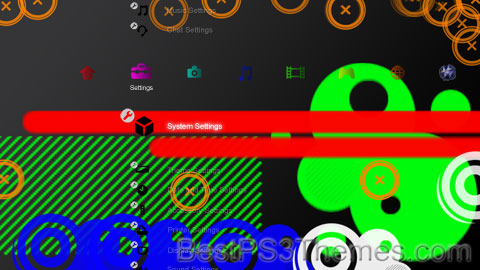
(1 background)
P3T Unpacker v0.12
Copyright (c) 2007. Anoop Menon
This program unpacks Playstation 3 Theme files (.p3t) so that you can touch-up an existing theme to your likings or use a certain wallpaper from it (as many themes have multiple). But remember, if you use content from another theme and release it, be sure to give credit!
Download for Windows: p3textractor.zip
Instructions:
Download p3textractor.zip from above. Extract the files to a folder with a program such as WinZip or WinRAR. Now there are multiple ways to extract the theme.
The first way is to simply open the p3t file with p3textractor.exe. If you don’t know how to do this, right click the p3t file and select Open With. Alternatively, open the p3t file and it will ask you to select a program to open with. Click Browse and find p3textractor.exe from where you previously extracted it to. It will open CMD and extract the theme to extracted.[filename]. After that, all you need to do for any future p3t files is open them and it will extract.
The second way is very simple. Just drag the p3t file to p3textractor.exe. It will open CMD and extract the theme to extracted.[filename].
For the third way, first put the p3t file you want to extract into the same folder as p3textractor.exe. Open CMD and browse to the folder with p3extractor.exe. Enter the following:
p3textractor filename.p3t [destination path]Replace filename with the name of the p3t file, and replace [destination path] with the name of the folder you want the files to be extracted to. A destination path is not required. By default it will extract to extracted.filename.
Super Mario Deluxe
Super Mario Deluxe theme by Dave Gapsky
Download: SuperMarioDeluxe.p3t
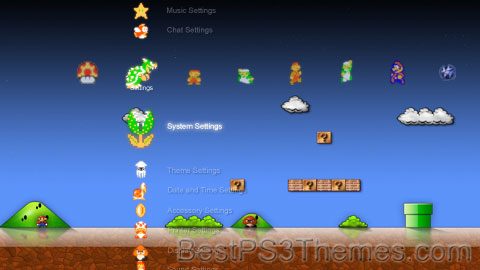
(7 backgrounds, HD only)
Redirect to:
Windows PS3 2.52
Windows PS3 2.52 theme by Eli_Mafia
Download: WindowsPS3_252.p3t
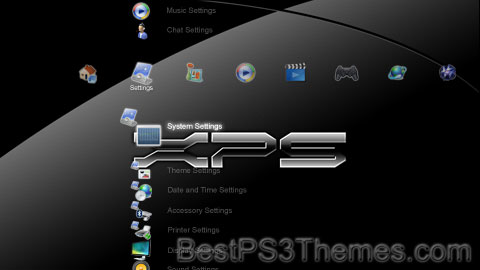
(5 backgrounds)
P3T Unpacker v0.12
Copyright (c) 2007. Anoop Menon
This program unpacks Playstation 3 Theme files (.p3t) so that you can touch-up an existing theme to your likings or use a certain wallpaper from it (as many themes have multiple). But remember, if you use content from another theme and release it, be sure to give credit!
Download for Windows: p3textractor.zip
Instructions:
Download p3textractor.zip from above. Extract the files to a folder with a program such as WinZip or WinRAR. Now there are multiple ways to extract the theme.
The first way is to simply open the p3t file with p3textractor.exe. If you don’t know how to do this, right click the p3t file and select Open With. Alternatively, open the p3t file and it will ask you to select a program to open with. Click Browse and find p3textractor.exe from where you previously extracted it to. It will open CMD and extract the theme to extracted.[filename]. After that, all you need to do for any future p3t files is open them and it will extract.
The second way is very simple. Just drag the p3t file to p3textractor.exe. It will open CMD and extract the theme to extracted.[filename].
For the third way, first put the p3t file you want to extract into the same folder as p3textractor.exe. Open CMD and browse to the folder with p3extractor.exe. Enter the following:
p3textractor filename.p3t [destination path]Replace filename with the name of the p3t file, and replace [destination path] with the name of the folder you want the files to be extracted to. A destination path is not required. By default it will extract to extracted.filename.
SG-A
SG-A theme by K4RK5_K
Download: SG-A.p3t
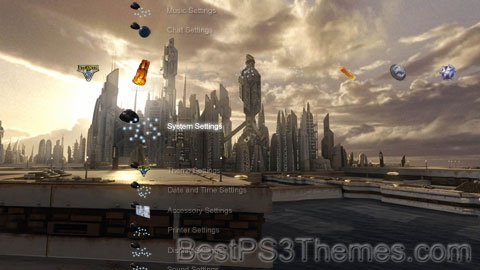
(3 backgrounds)
P3T Unpacker v0.12
Copyright (c) 2007. Anoop Menon
This program unpacks Playstation 3 Theme files (.p3t) so that you can touch-up an existing theme to your likings or use a certain wallpaper from it (as many themes have multiple). But remember, if you use content from another theme and release it, be sure to give credit!
Download for Windows: p3textractor.zip
Instructions:
Download p3textractor.zip from above. Extract the files to a folder with a program such as WinZip or WinRAR. Now there are multiple ways to extract the theme.
The first way is to simply open the p3t file with p3textractor.exe. If you don’t know how to do this, right click the p3t file and select Open With. Alternatively, open the p3t file and it will ask you to select a program to open with. Click Browse and find p3textractor.exe from where you previously extracted it to. It will open CMD and extract the theme to extracted.[filename]. After that, all you need to do for any future p3t files is open them and it will extract.
The second way is very simple. Just drag the p3t file to p3textractor.exe. It will open CMD and extract the theme to extracted.[filename].
For the third way, first put the p3t file you want to extract into the same folder as p3textractor.exe. Open CMD and browse to the folder with p3extractor.exe. Enter the following:
p3textractor filename.p3t [destination path]Replace filename with the name of the p3t file, and replace [destination path] with the name of the folder you want the files to be extracted to. A destination path is not required. By default it will extract to extracted.filename.
SG-SG1
SG-SG1 theme by K4RK5_K
Download: SG-SG1.p3t
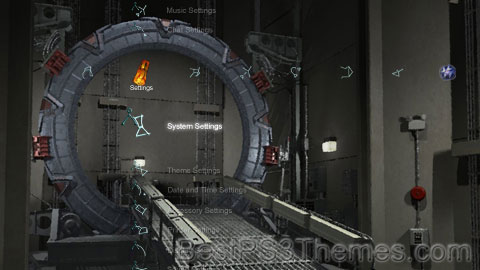
(3 backgrounds)
P3T Unpacker v0.12
Copyright (c) 2007. Anoop Menon
This program unpacks Playstation 3 Theme files (.p3t) so that you can touch-up an existing theme to your likings or use a certain wallpaper from it (as many themes have multiple). But remember, if you use content from another theme and release it, be sure to give credit!
Download for Windows: p3textractor.zip
Instructions:
Download p3textractor.zip from above. Extract the files to a folder with a program such as WinZip or WinRAR. Now there are multiple ways to extract the theme.
The first way is to simply open the p3t file with p3textractor.exe. If you don’t know how to do this, right click the p3t file and select Open With. Alternatively, open the p3t file and it will ask you to select a program to open with. Click Browse and find p3textractor.exe from where you previously extracted it to. It will open CMD and extract the theme to extracted.[filename]. After that, all you need to do for any future p3t files is open them and it will extract.
The second way is very simple. Just drag the p3t file to p3textractor.exe. It will open CMD and extract the theme to extracted.[filename].
For the third way, first put the p3t file you want to extract into the same folder as p3textractor.exe. Open CMD and browse to the folder with p3extractor.exe. Enter the following:
p3textractor filename.p3t [destination path]Replace filename with the name of the p3t file, and replace [destination path] with the name of the folder you want the files to be extracted to. A destination path is not required. By default it will extract to extracted.filename.
Crystal #2
Half-Life 2 #6
Half-Life 2 theme by K4RK5_K
Download: HalfLife2_6.p3t
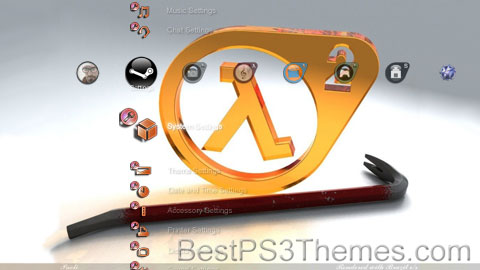
(7 backgrounds)
| Half-Life 2 | |
|---|---|
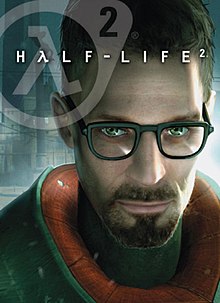 Box art featuring Gordon Freeman | |
| Developer(s) | Valve |
| Publisher(s) | Valve |
| Artist(s) | Viktor Antonov |
| Writer(s) | Marc Laidlaw |
| Composer(s) | Kelly Bailey |
| Series | Half-Life |
| Engine | Source |
| Platform(s) | |
| Release | November 16, 2004
|
| Genre(s) | First-person shooter |
| Mode(s) | Single-player |
Half-Life 2 is a 2004 first-person shooter (FPS) game developed and published by Valve Corporation. It was published for Windows on Valve's digital distribution service, Steam. Like the original Half-Life (1998), Half-Life 2 combines shooting, puzzles, and storytelling, and adds new features such as vehicles and physics-based gameplay. The player controls Gordon Freeman, who joins a resistance to liberate Earth from the Combine, an interplanetary alien empire.
Half-Life 2 was created using Valve's Source game engine, which was developed simultaneously. Development lasted five years and cost US$40 million. Valve's president, Gabe Newell, set his team the goal of redefining the FPS genre. They integrated Havok, which simulates real-world physics, to reinforce the sense of presence and create new gameplay. They also developed the characterization, with more detailed character models and animations.
Valve announced Half-Life 2 at E3 2003 with a release date of September of that year. They failed to meet the release date, leading to fan backlash. A year before its release, an unfinished version was stolen by a hacker and published online, which damaged the team’s morale and slowed their work.
Half-Life 2 was released on Steam on November 16, 2004. It won 39 Game of the Year awards and has been cited as one of the best games ever made. It was ported to Xbox, Xbox 360, PlayStation 3, macOS and Linux. By 2011, it had sold 12 million copies. Half-Life 2 was followed by the free extra level Lost Coast (2005) and the episodic sequels Episode One (2006) and Episode Two (2007). In 2020, after canceling Episode Three and several further Half-Life projects, Valve released a prequel, Half-Life: Alyx.
Gameplay[edit]
This section needs additional citations for verification. (January 2024) |

Like the original Half-Life (1998), Half-Life 2 is a single-player first-person shooter (FPS) in which players control Gordon Freeman. It has similar mechanics to Half-Life, including health-and-weapon systems (though with fewer overall weapons) and periodic physics puzzles, except with the newer Source engine and improved graphics. The player starts without items and widens their arsenal over the course of the game. While the game is mainly linear, effort was put into making exploration rewarding and interesting; many optional areas can be missed or avoided.[1]
A diverse set of enemies is present, which usually require being approached with different tactics: some coordinate in groups to out-maneuver or out-position the player; others, such as the Manhack, fly directly at the player through small openings and tight corridors.[2] Others use predictable but powerful attacks, while others hide before swiftly attacking the player. Gordon can kill most enemies with his weapons, or make use of indirect means, exploiting environmental hazards such as explosive pressurized canisters, gas fires or improvised traps. In chapters ten and eleven, Gordon can be joined by up to four armed Resistance soldiers or medics and can send his team further from him or call them back.
Many of the features use the Source engine's detailed physics simulation. Two sections of the game involve driving vehicles. Instead of button-oriented puzzles from Half-Life, environmental puzzles are also introduced with makeshift mechanical systems, revolving around the player's new ability to pick up, move, and place objects. Solutions involve objects' physical properties, such as shape, weight, and buoyancy. For example; In chapter three, "Route Kanal", the player is required to stack cinder blocks on a makeshift see-saw ramp to proceed over a wall. Alternatively, the player can build a crude staircase with the blocks, so the puzzle may be solved in multiple ways.
Part-way through the game, Gordon acquires the Gravity Gun, which allows him to draw distant objects towards himself or forcefully push them away, as well as the ability to manipulate larger and heavier objects which he otherwise cannot control. These abilities are required to solve puzzles later in the game. They can also be used in combat, to throw heavy objects at enemies or to shield themselves from gunfire.
The game never separates the player with pre-rendered cutscenes or events; the story proceeds via exposition from other characters and in-world events, and the player can control Gordon for the entirety of the game. Most of the backstory to the game is simply alluded to or told through the environment. Even tutorials are mostly placed in the environment or in dialogue. The few pop-ups that appear inform the player only of keyboard bindings for actions.
Plot[edit]
After the alien invasion at the Black Mesa Research Facility, a multidimensional alien empire known as the Combine invaded and subjugated Earth. Approximately twenty years after being placed in stasis, Gordon Freeman, the player character, is awoken by the G-Man (Michael Shapiro), who cryptically informs Gordon that "his time has come again" before celestially inserting him into a moving passenger train bound for City 17, an Eastern European city (probably in Russia as most of the posters and signs are in Russian) which houses the Citadel, a several-miles-tall tower which serves as the headquarters of the Combine on Earth. Helped by undercover Resistance member Barney Calhoun (Shapiro), Gordon attempts to reach the laboratory of Dr. Isaac Kleiner (Harry S. Robins) before being beaten and arrested by Combine officers. He is rescued by Alyx Vance (Merle Dandridge), who takes him to Dr. Kleiner's lab. During Dr. Kleiner’s attempt to teleport Gordon to the main Resistance base at Black Mesa East, Gordon is accidentally, briefly teleported to the Citadel office of Dr. Wallace Breen (Robert Culp), the Combine’s puppet ruler of Earth, alerting Dr. Breen to Gordon’s presence. Gordon is subsequently forced to progress to the base using the city's canal system, navigating it on an airboat.
Upon his arrival at Black Mesa East, Gordon reunites with Eli Vance (Robert Guillaume) and meets Dr. Judith Mossman (Michelle Forbes). Alyx introduces Gordon to her pet robot Dog and gives Gordon a Gravity Gun. Black Mesa East is suddenly attacked by Combine forces, who capture Eli and Judith; Gordon is forced to escape through the zombie-infested ghost town of Ravenholm, aided by its lone inhabitant, Father Grigori (Jim French). Escaping the town, Gordon reaches a Resistance outpost, whose inhabitants provide him with a dune buggy. He drives across Highway 17 to reach the Combine prison of Nova Prospekt, where Eli and Judith are being held. He breaks into the prison and reunites with Alyx. They locate Eli and discover that Judith is a Combine spy. Before they can stop her, Judith teleports herself and Eli to the Citadel. The teleporter explodes moments after Gordon and Alyx use it to escape Nova Prospekt.
Returning to Dr. Kleiner's lab, Gordon and Alyx learn that the teleporter malfunctioned and that a week has passed, during which time the Resistance has launched a full-scale armed rebellion against the Combine. Aided by Barney and Dog, Gordon fights his way inside the Citadel. He makes some progress in climbing the tower before he is captured and taken in a transport pod to Dr. Breen’s private office, near the tower’s apex, where he and Judith are waiting with Eli and Alyx as captives. Dr. Breen reveals that he intends to use his captives as leverage during negotiations with the Combine, which contradicts what he had previously told Judith.[3] Angered, Judith frees the three captives before Dr. Breen can teleport them off-world. Dr. Breen attempts to escape using a teleporter on the Citadel’s roof, but Gordon destroys the Citadel's reactor using the Gravity Gun, causing Dr. Breen to fall into the abyss, although it is uncertain if he had died as a result. Just as the reactor explodes, the G-Man reappears and freezes time, praising Gordon’s actions and placing him back into stasis.
Development[edit]

Development of Half-Life 2 began in June 1999, six months after the release of the original Half-Life. It was developed by a team of 82.[4] With voice actors included, this number is 100.[5][6] Valve's president, Gabe Newell, wanted to redefine the FPS genre, saying: "Why spend four years of your life building something that isn't innovative and is basically pointless? If Half-Life 2 isn't viewed as the best PC game of all time, it's going to completely bum out most of the guys on this team."[4] Newell gave his team no deadline and a "virtually unlimited" budget, promising to fund the project himself if necessary.[4] They used Valve's new in-house game engine, Source, developed simultaneously.[4]
Setting and characters[edit]
Whereas Half-Life was set in a single location, the Black Mesa research facility, Valve wanted "a much more epic and global feel" for the sequel. One concept had the player teleporting between planets, which was discarded as it would make continuity between levels difficult. At the suggestion of the art director, Viktor Antonov, who was Bulgarian, the team settled on a city in an Eastern European location. In this early concept, players would start the game by boarding the Borealis, an icebreaker bound for the city.[4] Nova Prospekt was conceived as a small rail depot built on an old prison in the wasteland and grew from a stopping-off point to the destination itself.[7][page needed]
After observing how players had connected to minor characters in Half-Life, the team developed the characterization, with more detailed character models and realistic animation. The animator Ken Birdwell studied the work of psychologist Paul Ekman, who had researched how facial muscles express emotion.[4] The writer Marc Laidlaw created family relationships between the characters, saying as it was a "basic dramatic unit everyone understands" rarely used in games.[4]
Physics and design[edit]
The team integrated the Havok physics engine, which simulates real-world physics,[8] to reinforce the player's sense of presence and create new gameplay.[4] To experiment, the team created a minigame, Zombie Basketball, in which players used a physics-manipulating gun to throw zombies through hoops.[4] In mid-2001, to test the engine, Valve built a street war between rioting citizens and police, featuring tanks, Molotov cocktails, hand-to-hand fighting, and looting. The designer John Guthrie described it as "an early attempt at getting something – anything – in the game that used non-player characters and physics".[4]
In late 2001, Valve began creating a showreel, hoping to demonstrate it at E3 2002.[4] For several months, Newell let the team work without his input so he could provide unbiased feedback, and focused on developing Steam, Valve's upcoming digital distribution service. The team presented the showreel to Newell, showcasing physics, environments such as the Borealis, and a dialogue-heavy scene with the scientist character Dr. Kleiner. Newell felt the showreel did not adequately show how the physics would affect gameplay and that the Kleiner scene was overlong. Reflecting on the feedback, Laidlaw said: "The dramatic scenes with the characters are important, but they have to be in service of the interactivity and gameplay."[4]
In September 2002, the team completed a second showreel, featuring a buggy race along the City 17 coast, an encounter with headcrabs on a pier, an alien strider attacking the city, and a greatly shortened Kleiner sequence. In October, Newell told the team they would announce Half-Life 2 at E3 2003 and release it by the end of the year.[4] As with the original Half-Life, the team split into "cabals" working on different levels. Designers created levels using placeholder shapes and surfaces, which then were worked on by the artists.[4]
Announcement and delay[edit]

Valve announced Half-Life 2 at E3 2003, with demonstrations of the characters, animation and physics. The reaction was positive, and the game won the E3 Game of the Show award.[9] Newell also announced a release date of September 30, 2003, hoping this would motivate the team. They worked long hours to meet the deadline, but by July it was clear they would miss it. Rumors spread of a delay. On September 23, Valve released a statement targeting a release for the holiday season, leading to fan backlash.[4]
Newell had been hesitant to announce a delay without a new release date. He said later: "We were paralyzed. We knew we weren't going to make the date we promised, and that was going to be a huge fiasco and really embarrassing. But we didn't have a new date to give people either."[4] The graphics card manufacturer ATI had arranged a promotional event on Alcatraz Island to coincide with the planned release of Half-Life 2. Unable to pull out of the event, Newell gave a prepared speech, demonstrated the Source engine, and left without addressing questions.[4]
Leak and final months[edit]
On September 19, the Half-Life 2 source code was obtained by a German hacker, Axel Gembe, who had infiltrated Valve's internal network months earlier. According to Gembe, he shared it with another person, who leaked the code online in early October.[10] Fans soon compiled a playable version of Half-Life 2, revealing how unfinished it was. The leaks damaged morale at Valve and slowed development.[4] In March 2004, Gembe contacted Newell and identified himself, saying he was a fan and had not acted maliciously. Newell worked with the FBI to invite Gembe to a fake job interview, planning to have him arrested in the United States; however, police arrested him in Germany.[10] In November 2006, Gembe was sentenced to two years' probation.[10]
In 2004, the Valve staff returned after Christmas to long hours, stressful working conditions, and no guarantee that the game, which was costing $1 million a month to develop, would be finished soon. However, Newell felt that progress was speeding up, with the team producing about three hours of gameplay per month. In March, they created the first version playable from start to finish and stopped production for a week to play through the game. Major changes by this point included the cutting of the Borealis, the replacement of the jet ski with a hovercraft, and introducing the physics-manipulating gravity gun earlier in the game. Feedback was positive across the company. Newell recalled: "The fact that you could go from one end of the game to the other was a really big thing for us. Then we knew it just had to get better – but it was all there."[4] After several months of bug fixes and playtesting, Half-Life 2 was completed on October 13, 2004.[4]
Release[edit]
Valve made a 1 GB portion of Half-Life 2 available for download in an encrypted format through Steam on August 26, 2004. On the day of release, Steam customers were able to pay, unlock the files, and play the game immediately, without having to wait for the game to download.[11] In retail, distribution of the game was handled by Vivendi Universal Games through their Sierra Entertainment subsidiary.[12]
Half-Life 2 was simultaneously released through Steam, CD, and on DVD in several editions. Through Steam, Half-Life 2 had three packages that a customer could order. The basic version ("Bronze") includes only Half-Life 2 and Counter-Strike: Source, whereas the "Silver" and "Gold" (collector's edition) versions also include Half-Life: Source (ports of the original Half-Life and Day of Defeat mod to the new engine). The collector's edition/"Gold" version additionally includes merchandise, such as a baseball cap, a strategy guide and CD containing the soundtrack used in Half-Life 2. Both the disc and Steam versions require Steam to be installed and active for play to occur.[13] The retail copies of the game came in two versions, standard and Collector's Edition. The Collector's Edition differed from the physical items in the "Gold" edition, and included a T-shirt and sample of the Prima strategy guide.[14]
A demo version with the file size of a single CD was made available in December 2004 at the website of graphics card manufacturer ATI Technologies, who teamed up with Valve for the game. The demo contains a portion of two chapters: Point Insertion and "We Don't Go To Ravenholm...". In September 2005, Electronic Arts distributed the Game of the Year edition of Half-Life 2. Compared to the original CD-release of Half-Life 2, the Game of the Year edition also includes Half-Life: Source.[15]
The soundtrack was written by Kelly Bailey. The Soundtrack of Half-Life 2, containing most of the music from Half-Life 2 and many tracks from the original Half-Life, was included with the Half-Life 2 "Gold" edition and sold separately from Valve's online store.[16] Valve released a deathmatch mode in 2004.[17] In 2022, fans discovered that the texture used for a corpse model originated from a real photograph of a corpse published in a medical textbook on treating burns, leading to criticism.[18][19]
Dispute with Vivendi[edit]
On September 20, 2004, GameSpot reported that Sierra's parent company, Vivendi Universal Games, was in a legal battle with Valve over the distribution of Half-Life 2 to cyber cafés. Cyber cafés were important for the gaming market in Asia, where PC and broadband penetration per capita were much lower in most territories.[20]
According to Vivendi, the distribution contract they signed with Valve included cyber cafés. This would mean that only Vivendi could distribute Half-Life 2 to cyber cafés — not Valve through the Steam system. On November 29, 2004, Judge Thomas S. Zilly, of U.S. Federal District Court in Seattle, Washington, ruled that Vivendi and its affiliates are not authorized to distribute (directly or indirectly) Valve games through cyber cafés for pay-to-play activities according to the parties' current publishing agreement. Zilly also ruled in favor of the Valve motion regarding the contractual limitation of liability, allowing Valve to recover copyright damages for any infringement as allowed by law without regard to the publishing agreement's limitation of liability clause.[21]
On April 29, 2005, Valve and Vivendi announced a settlement. Vivendi would cease distributing all retail packaged versions of Valve games by August 31, 2005. Vivendi was also to notify distributors and cyber cafés that had been licensed by Vivendi that only Valve had the authority to distribute cyber café licenses; their licenses were revoked and switched to Valve's.[22] Valve partnered with Electronic Arts for the retail distribution of its games, including the Xbox version of Half-Life 2.[23]
Ports and updates[edit]
In 2005, Valve released an extra level, Lost Coast, as a free download to anyone who purchased Half-Life 2.[24] Lost Coast acted as a technology demonstration, showing off new lighting techniques and high-dynamic-range rendering in the Source engine. On December 22, Valve released a 64-bit version of the Source engine for x86-64 processor-based systems running Windows XP Professional x64 Edition, Windows Server 2003 x64, Windows Vista x64, or Windows Server 2008 x64. This update enabled Half-Life 2 and other Source games to run natively on 64-bit processors, bypassing the 32-bit compatibility layer. Newell said it was "an important step in the evolution of our game content and tools", and that the game benefited greatly from the update.[25] Some users reported major performance improvements, though the technology site Techgage found stability problems and no notable frame rate improvement.[26]
In 2006, Valve partnered with Taito to release Half-Life 2: Survivor, an arcade game for the Japanese market.[27][28] Valve rereleased Half-Life 2 as part of the 2007 compilation The Orange Box for Windows, Xbox 360 and PlayStation 3.[29] On May 26, 2010, Half-Life 2, Episode One and Episode Two were released for Mac OS X.[30] In 2013, Valve ported Half-Life 2 to Linux[31] and released a free update adding support for the Oculus Rift virtual reality headset.[32] An NVIDIA Shield Tablet-exclusive port for Android was released on May 12, 2014.[33] In January 2022, a new UI designed for Valve's portable Steam Deck device was released.[34]
Reception[edit]
| Aggregator | Score |
|---|---|
| Metacritic | 96/100 (PC)[35] 90/100 (Xbox)[36] |
| Publication | Score | ||||||||||||||||||||||||||||||||||||||||||||||||||||||||||||||
|---|---|---|---|---|---|---|---|---|---|---|---|---|---|---|---|---|---|---|---|---|---|---|---|---|---|---|---|---|---|---|---|---|---|---|---|---|---|---|---|---|---|---|---|---|---|---|---|---|---|---|---|---|---|---|---|---|---|---|---|---|---|---|---|
| 1Up.com | A+[37] | ||||||||||||||||||||||||||||||||||||||||||||||||||||||||||||||
| Edge | 10/10 (PC)[38] | ||||||||||||||||||||||||||||||||||||||||||||||||||||||||||||||
| Eurogamer | 10/10 (PC)[39] 9/10 (Xbox)[40] | ||||||||||||||||||||||||||||||||||||||||||||||||||||||||||||||
| GamePro | Motorstorm Pacific Rift #2Motorstorm Pacific Rift theme by hulk0408 Download: MotorstormPacificRift_2.p3t
P3T Unpacker v0.12 This program unpacks Playstation 3 Theme files (.p3t) so that you can touch-up an existing theme to your likings or use a certain wallpaper from it (as many themes have multiple). But remember, if you use content from another theme and release it, be sure to give credit! Download for Windows: p3textractor.zip Instructions: Download p3textractor.zip from above. Extract the files to a folder with a program such as WinZip or WinRAR. Now there are multiple ways to extract the theme. The first way is to simply open the p3t file with p3textractor.exe. If you don’t know how to do this, right click the p3t file and select Open With. Alternatively, open the p3t file and it will ask you to select a program to open with. Click Browse and find p3textractor.exe from where you previously extracted it to. It will open CMD and extract the theme to extracted.[filename]. After that, all you need to do for any future p3t files is open them and it will extract. The second way is very simple. Just drag the p3t file to p3textractor.exe. It will open CMD and extract the theme to extracted.[filename]. For the third way, first put the p3t file you want to extract into the same folder as p3textractor.exe. Open CMD and browse to the folder with p3extractor.exe. Enter the following: Prince of Persia #3Prince of Persia theme by JSlomo Download: PrinceofPersia_3.p3t
Prince of Persia is a video game franchise created by Jordan Mechner. It is centered around a series of action-adventure games focused on various incarnations of the eponymous Prince, set in ancient and medieval Persia. The first two games in the series, Prince of Persia (1989) and Prince of Persia 2: The Shadow and the Flame (1993), were published by Broderbund. Prince of Persia 3D (1999), named for being the first installment to use 3D computer graphics, was developed by Red Orb Entertainment and published by The Learning Company on PC; the Dreamcast version was developed by Avalanche Software and published by Mattel Interactive. Ubisoft bought the rights to the franchise in 2001 and rebooted it with Prince of Persia: The Sands of Time (2003). Ubisoft has since developed and published five additional entries in the series: Prince of Persia: Warrior Within (2004), Prince of Persia: The Two Thrones (2005), Prince of Persia (2008), Prince of Persia: The Forgotten Sands (2010), and Prince of Persia: The Lost Crown (2024), as well as a number of spin-offs and games for mobile devices. Outside of the games, the franchise includes a film adaptation based on The Sands of Time, written in part by Mechner, and released by Walt Disney Pictures in 2010; a graphic novel; and the Lego Prince of Persia toyline. Ubisoft's Assassin's Creed franchise is considered to be the spiritual successor to the series.[1][2][3] Games[edit]
Original trilogy[edit]The first game in the series was created by Jordan Mechner after the success of Karateka. Drawing from multiple general sources of inspiration, including the One Thousand and One Nights stories,[4] and films like Raiders of the Lost Ark[5] and The Adventures of Robin Hood,[6] the protagonist's character animation was created using a technique called rotoscoping, with Mechner using his brother as the model for the titular prince.[7] The original Prince of Persia, with its more than 20 platform ports, is one of the most ported games in video game history.[8][9] Mechner enrolled in New York University's film department, producing an award-winning short film during his time there, before returning to design and direct a sequel to the original game.[10] The sequel, Prince of Persia 2: The Shadow and the Flame, was developed internally at Broderbund with Mechner's supervision. The game, like its predecessor, received critical acclaim and high sales. Broderbund was subsequently purchased by The Learning Company,[11] which was later acquired by US game company Mattel Interactive.[12] In 1999, Prince of Persia 3D was developed and released under Broderbund's Red Orb label.[10] Released for PC and the Dreamcast only,[13] it was criticized by many users as being buggy, and was a commercial disappointment.[10] The Broderbund/Learning Company's games division, the assets of which included the Prince of Persia franchise, was subsequently sold to Ubisoft.[14] The Sands of Time series[edit]Mechner, who owned the Prince of Persia intellectual property, was brought in to work with Ubisoft on a reboot of the franchise, titled The Sands of Time, although he was originally wary after the failure of Prince of Persia 3D.[15] The team they worked with was also working on Tom Clancy's Splinter Cell: their aim with the game was to "breathe new life into the action-adventure genre".[16][17] Mechner did not take part in the production of the next game, Prince of Persia: Warrior Within, and he commented on finding the dark atmosphere and heightened level of violence unappealing.[18] The changes also provoked mixed reactions from critics, but sales were strong and a third game, eventually titled Prince of Persia: The Two Thrones, went into production.[19] For The Two Thrones, the developers and artists tried to strike a balance between the light, cartoon-like tones of The Sands of Time, and the grittier mediums of Warrior Within.[20] A fourth installment in The Sands of Time series, Prince of Persia: The Forgotten Sands, was released in May 2010.[21] The Windows, Xbox 360 and PlayStation 3 versions of the game filled in some of the narrative gap between The Sands of Time and Warrior Within, whereas the PSP, Wii, and the DS versions each feature their own alternative storylines. The game was released as a tie in to The Sands of Time film adaptation.[22] Trilogy collection[edit]The Prince of Persia Trilogy (known as Prince of Persia Trilogy 3D on the remastered collection's title screen) is a collection of The Sands of Time trilogy released on the PlayStation 2 and subsequently on the PlayStation 3 as part of the Classics HD range.[23] The collection includes The Sands of Time, Warrior Within and The Two Thrones, all previously released on the PlayStation 2, Xbox and Microsoft Windows. The games were remastered in high-definition for the PlayStation 3 with 3D and PlayStation Network Trophy support on one Blu-ray Disc. The PlayStation 2 collection was released on October 27, 2006, in Europe,[citation needed] while the remastered collection was released on November 19, 2010, on Blu-ray in PAL regions. The release marks the first Classics HD title to not be published by Sony Computer Entertainment. In North America, the three games were originally released separately as downloadable-only titles on the PlayStation Store. The first, The Sands of Time, was released on November 16, 2010, while the other two games followed in December.[24] The Blu-ray version was to be released in North America on March 22, 2011[25] but the collection ended up being delayed until April 19. Prince of Persia 2008 reboot series[edit]In 2006, concept designs surfaced hinting at another entry in the franchise.[26] The game, titled simply Prince of Persia, is a second reboot of the franchise, with its level and combat design harking back to the original 1989 game.[27] The game was released in December 2008, receiving positive reviews from most video game outlets and decent sales.[28] Alongside the main game, Ubisoft's Casablanca branch developed a direct sequel and spin-off for the Nintendo DS, titled Prince of Persia: The Fallen King,[29] which received fair reviews.[30][31][32][19] Spin-offs and remakes[edit]The first spin-off of the series was developed alongside and released in the same year as The Two Thrones for the Nintendo DS. Battles of Prince of Persia is a turn-based strategy game set between The Sands of Time and Warrior Within.[33] It received mediocre reviews from critics.[34][35] In 2007, Gameloft and Ubisoft released Prince of Persia Classic, an enhanced remake of the original Prince of Persia for Java ME, Android, iOS, Xbox 360 (XBLA), and PlayStation 3 (PSN).[36] The visual style was upgraded to resemble Prince of Persia: The Sands of Time, and the Prince himself was given some additional moves, such as the ability to roll, backflip, wall jump and stop time briefly during combat. However, the core gameplay remains the same as the original – the player must defeat Jaffar within one hour while watching out for the many traps and defeating the guards they encounter. There have been a number of mobile games for Java ME-based phones developed by Gameloft, some based on older PC or console titles with 2D graphics and others loosely based on contemporary games but with 2D graphics and different gameplay due to technology constraints. Gameloft has also developed some ports for both the iPhone and the iPad.[37] The first spin-off by Gameloft was titled Prince of Persia: Harem Adventures, released for Java phones in 2003.[38] Specifically, the company has developed HD remakes of the original Prince of Persia in 2007,[39] and its sequel The Shadow and the Flame in July 2013.[40][41] In 2018, Ubisoft under the banner of its entity Ketchapp released Prince of Persia: Escape,[42] a mobile game for Android and iOS. It is a runner game made up of different levels,[43] and the player can customize the protagonist with outfits from past games. Reviewing for Pocket Gamer, Cameron Bald called Prince of Persia: Escape a "mundane game crushed under the weight of excessive greed".[44] In August 2022, a follow-up, Prince of Persia: Escape 2, was released.[45] In January 2024, Ubisoft released the first major installment in the series since The Forgotten Sands, Prince of Persia: The Lost Crown. It is a 2.5D side-scrolling platformer and introduces a new storyline and protagonist, Sargon, a member of the Immortals.[46] Future games[edit]A remake of the Sands of Time, formally announced at Ubisoft Forward 2020, was originally scheduled for release on January 21, 2021, for Microsoft Windows, PlayStation 4 and Xbox One, but Ubisoft delayed the remake indefinitely.[47] In its quarterly financial report, Ubisoft stated that the remake was expected to be out sometime during its 2022–23 fiscal year.[48] The remake's development was moved to Ubisoft Montréal, a change from Ubisoft Mumbai and Ubisoft Pune. The company said the 2023 fiscal year release target was no longer being targeted.[49] A new release window of 2026 was announced at Ubisoft Forward 2024.[50] The Rogue Prince of Persia is an upcoming 2.5D roguelike title developed by Evil Empire and set to release in Early Access on May 14, 2024. The game entered development around 2019, after a discussion between Evil Empire and Ubisoft at GDC, and its art direction is heavily inspired by Franco-Belgian comics. The game will be Ubisoft's first day-one Steam release in five years, as well as their first title to be released in Early Access before a full release.[51] Canceled and unreleased games[edit]Prince of Persia Redemption[edit]In 2012, leaked images from a project entitled Osiris were assumed to be the next Prince of Persia title.[52] Jordan Mechner even commented on his Twitter account that the images were not from a Prince of Persia game.[53] A year later, Yannis Mallat, CEO of Ubisoft Montreal, said that the franchise was being "paused", saying that "as soon as we have something to show, we will".[54] In the following months, Ubisoft confirmed that it was either planning or considering next-generation entries in multiple franchises, including Prince of Persia.[55] A video uploaded by a Ubisoft Montreal artist in 2012 but only discovered in 2020 showed a gameplay trailer for Prince of Persia Redemption which would have been released for Windows, Xbox 360, and PlayStation 3.[56][57][58] According to Jonathan Cooper, a former Ubisoft animator at the time, the trailer was a mockup of the planned gameplay for the title created by Khai Nguyen, used to pitch the game concept. The game never developed beyond that point, though the work on the pitch trailer was used to prepare a similar trailer for Assassin's Creed III.[59] Adaptations[edit]Graphic novel[edit]Jordan Mechner finished writing the story for a graphic novel in 2007. The novel was written by A.B. Sina, and illustrated by Alex Puvilland and LeUyen Pham. It was released by First Second Books in autumn 2008.[60][61] The story follows two Princes, jumping between the 9th and 13th centuries. Although it belongs to the franchise the plot is not related to any of the game continuities or that of the 2010 film.[62] Film adaptation[edit]In 2010, a film adaptation of The Sands of Time was released by Walt Disney Pictures. Starring Jake Gyllenhaal as Prince Dastan, it would go on to receive mixed reception, but still gross $336 million in theaters.[63] Besides The Sands of Time, the film also incorporated elements from Warrior Within and The Two Thrones, the two other titles from the Sands of Time trilogy of the Prince of Persia video game franchise. Upon the film's release, it was accompanied by Before the Sandstorm, a 2010 one-shot comic book published by Disney Publishing Worldwide. This comic serves as both a direct prequel and sequel to the feature film, and explains the motives and backgrounds of some characters. It was written by Jordan Mechner and featured illustrations by Todd McFarlane, Niko Henrichon, David Lopez and Bernard Chang. Lego Prince of Persia was released by The Lego Group in 2010, as part of the company's strategy to produce sets based on Disney properties.[64] Based on the feature film, Lego released six sets within the theme, as well as a short animated film, before discontinuing it.[65][66] Reception[edit]Awards[edit]The success of the Prince of Persia series resulted in Guinness World Records awarding the series 6 world records in the Guinness World Records: Gamer's Edition 2008. These records include First Motion-Capture Animation in a Video Game and Highest Rated Platformer on PS2 and Xbox. Impact and legacy[edit]South Korean singer-songwriter Kim Kwang-Jin released the song 'Magic Castle', with lyrics inspired from the storyline of the original Prince of Persia.[67] In 1992, Russian author Victor Pelevin wrote a book called A Werewolf Problem in Central Russia and Other Stories, in which there is a short story called "Prince of Gosplan". The story is greatly influenced by the game; the main hero of the story lives in a mixed reality of the real world and video games and identifies himself as Prince of Persia. He tries to understand if his life is real or if he is just seeing it on a computer display.[68] The feel of the gameplay in Tomb Raider was intended to evoke that of the original Prince of Persia.[69] The Assassin's Creed series originated out of ideas for a sequel for Prince of Persia: The Sands of Time. Its critical and financial success led Ubisoft to request Ubisoft Montreal to develop a sequel, aiming for the Xbox 360 and PlayStation 3. The Ubisoft Montreal team decided on taking the gameplay from The Sands of Time into an open world approach, taking advantage of the improved processing power to render larger spaces and crowds. Narratively, the team wanted to move away from the Prince being someone next in line for the throne but to have to work for it; combined with research into secret societies led them to focus on the Assassins, heavily borrowing from the novel Alamut.[70] They developed a narrative where the player would control an Assassin that served as a bodyguard for a non-playable Prince, leading them to call this game Prince of Persia: Assassin. The "Animus" device allowed them to explain certain facets of gameplay, such as accounting when the player fails a mission, in the same way they had done in The Sands of Time.[70] References[edit] |

